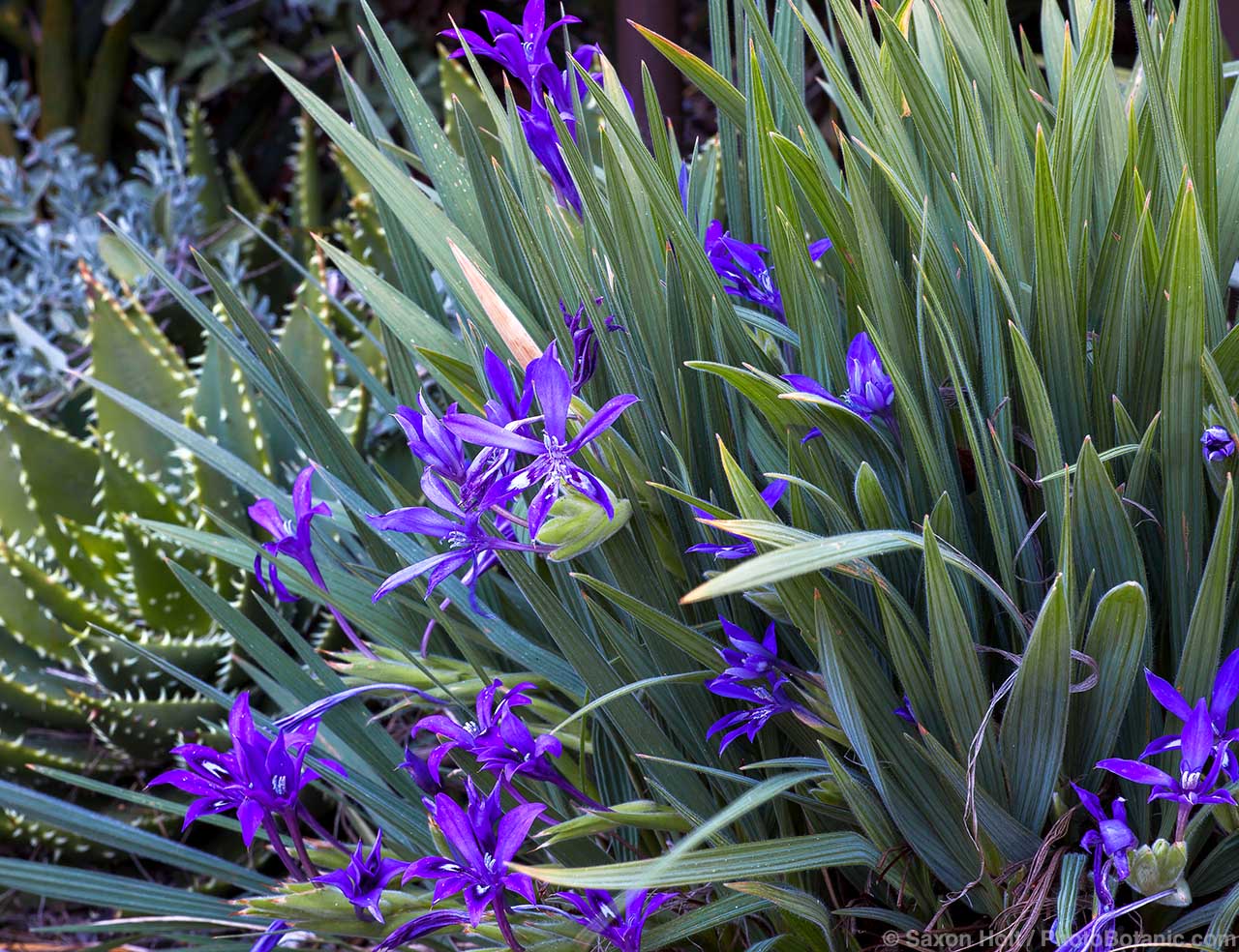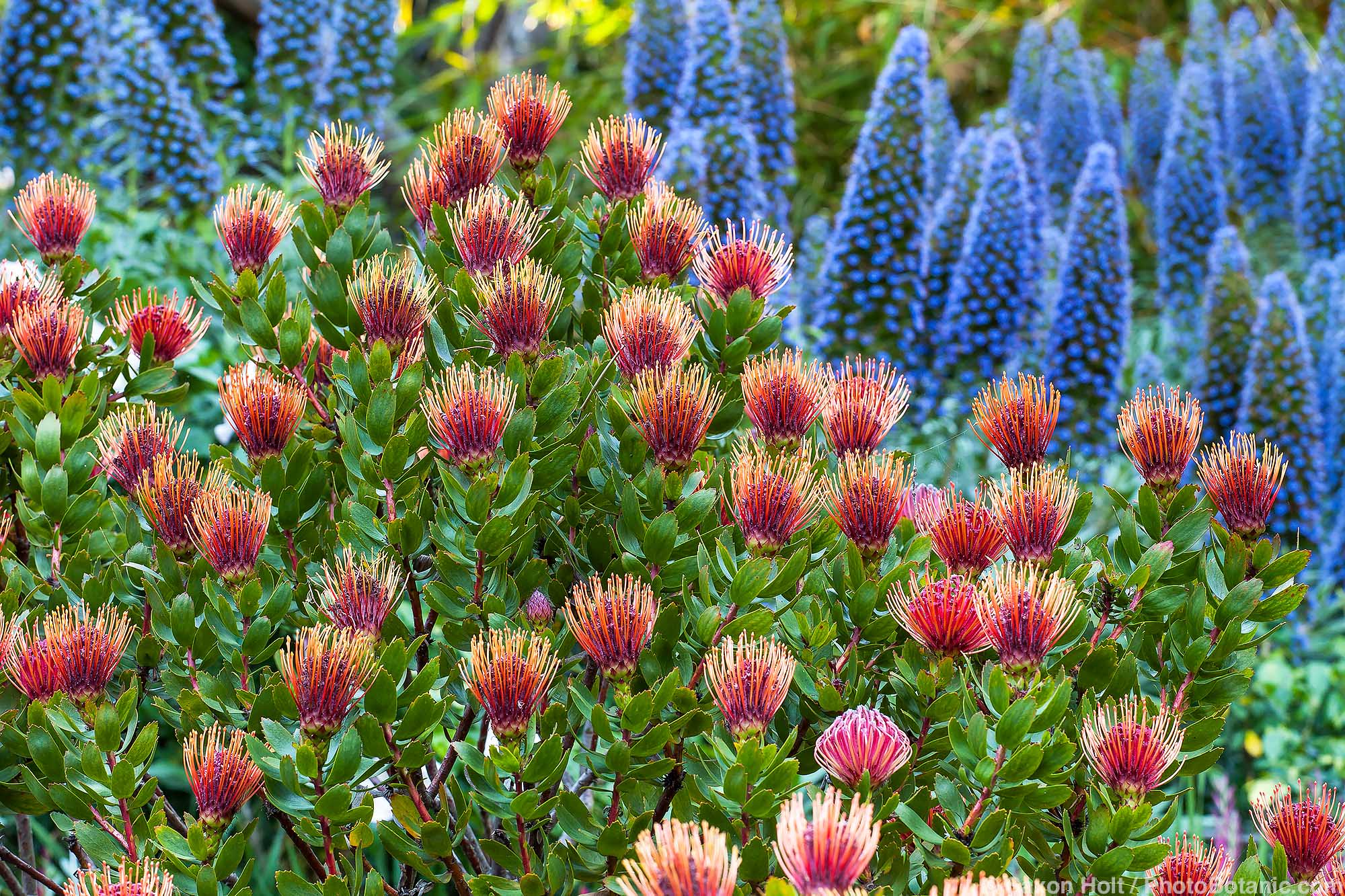Cultivated Varieties of Narcissus
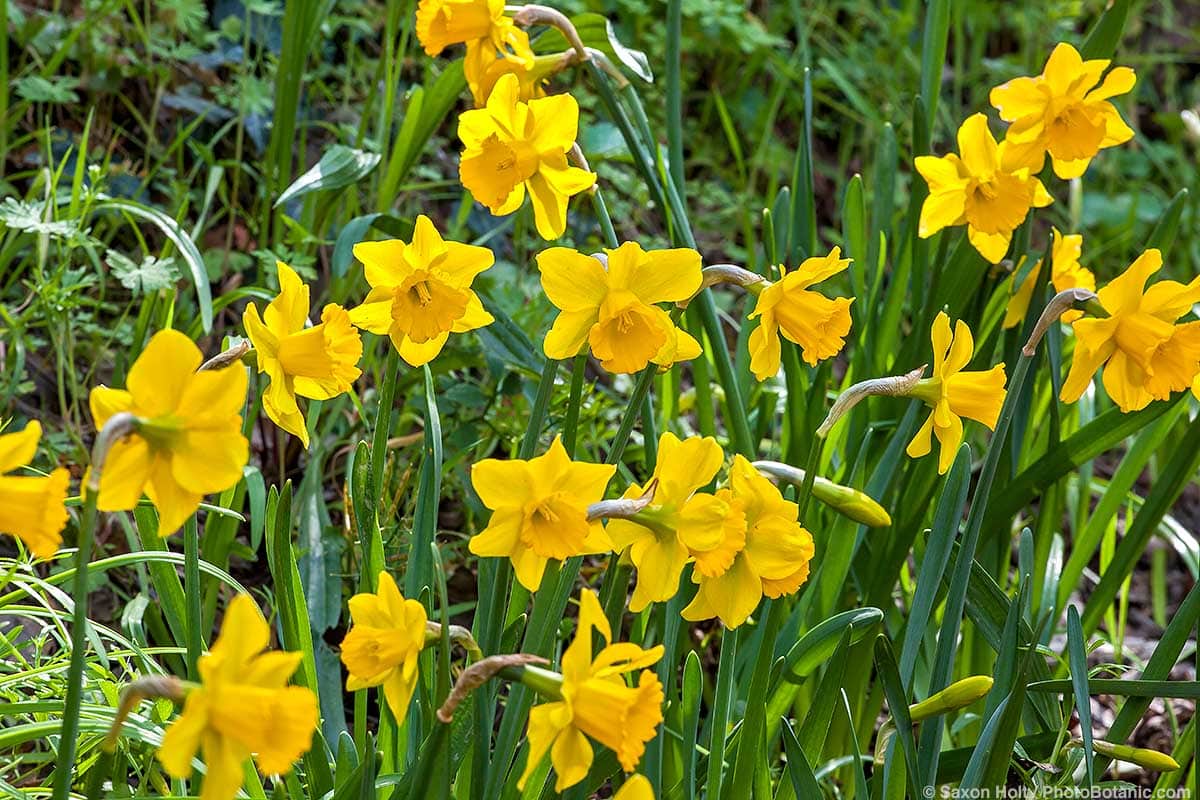
Share This!
Almost everyone has a childhood memory of daffodils, that universal symbol of the end of winter and the arrival, once again, of spring. Fewer likely know that the plant with which most of us are familiar is one among dozens of species and thousands of registered cultivars of the genus Narcissus, hundreds of which are currently in commercial production.
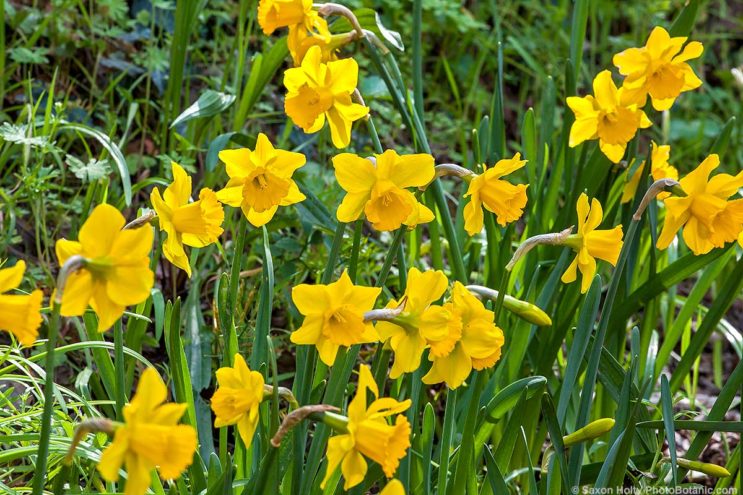
Narcissus ‘Grower’s Pride’
All narcissus are bulbs, all produce linear, strap-shaped, or sometimes rushlike basal leaves, and all bear flowers singly or in clusters of a few to many atop upright stems from six inches to two feet tall. Most narcissus species are native to summer-dry climates of the Mediterranean region.
Narcissus flowers have six spreading or sometimes reflexed petals (actually tepals), and most but not all have a central trumpet- or bowl-shaped structure called a corona or cup. Flowers are usually fragrant and are available with petals in shades of yellow to white with cups in matching or contrasting colors. Both petals and cups may subtly change color as flowers mature, and the color of one may bleed into the other.
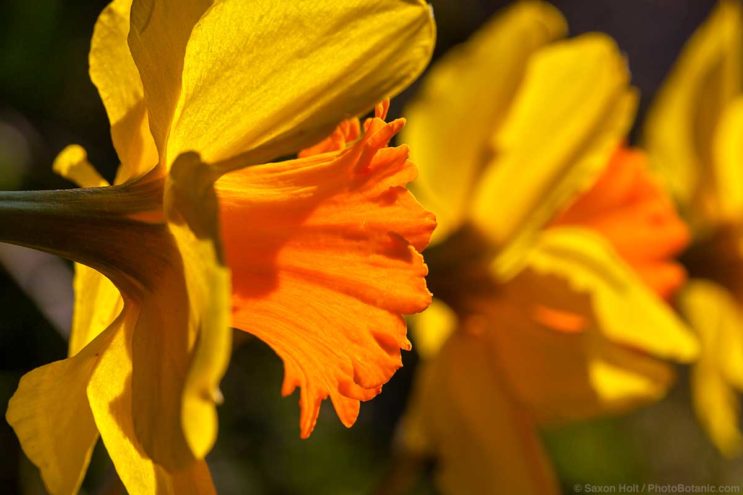
Narcissus ‘Falconet’
The taxonomy of Narcissus species is in some disarray, but cultivated plants are reliably classified by flower characteristics into twelve horticultural divisions, with the species lumped together in division thirteen. A combination of division number and letters referring to the color(s) of the flower is often used as a shorthand descriptor for plants listed in catalogs.
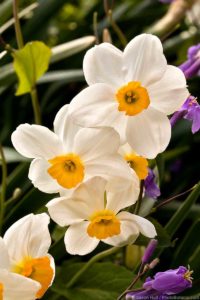
Narcissus ‘Geranium’
For example, the cultivar ‘Geranium’, a division eight narcissus with creamy white petals and a bowl-shaped, reddish orange cup, is assigned the code 8 W-O. The codes are useful in narrowing the search for a particular kind of narcissus to a quick scan of a long list of options.
The classic yellow daffodil, the ‘King Alfred’ our grandmothers grew, is no longer commercially produced, but similar versions are readily available, sometimes under such names as ‘King Alfred Improved’ or ‘King Alfred Jumbo’. These are among the many narcissus classified as division one, trumpet daffodils, a reference to their long, funnel- or trumpet-shaped cup.
Trumpet daffodils also come with pale creamy yellow or bright white petals and white, yellow, orange, red, pink, or even lime green cups, some with ruffled rims. Flowers are borne singly on stems that rise from less than a foot to 18 or 20 inches tall.
Cyclamineus narcissus, division six, have nodding or slightly nodding flowers with a long trumpet-shaped cup and petals reflexed or swept upward and back in the manner of cyclamen flowers. These are mostly miniature plants, 6-12 inches tall, with a single flower on each stem.
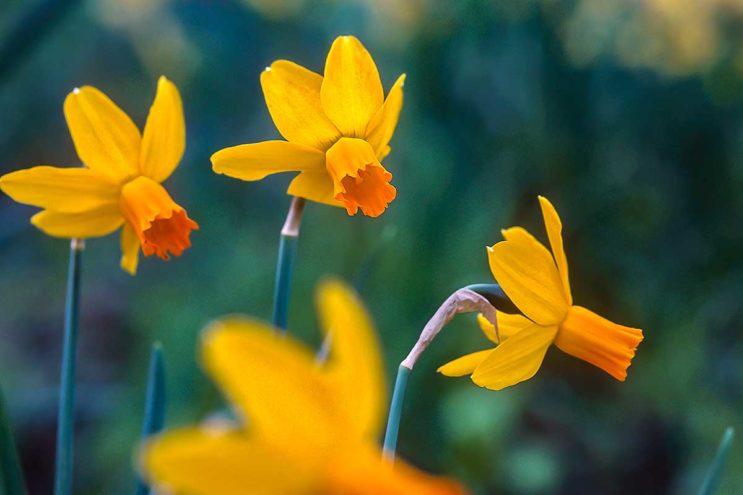
Narcissus ‘Itzim’
‘Itzim’ (6 Y-R) is a cyclamineus narcissus, 10-12 inches tall, with deep yellow petals and a trumpet-shaped cup that starts out the same color, then deepens to reddish orange and then to almost red. ‘February Gold’ (6 Y-Y) is about the same size, with sulfur yellow petals and a slightly darker yellow trumpet-shaped cup with a ruffled rim.
Jonquilla narcissus, or jonquils, are tender bulbs with narrow, grasslike or rushlike, dark green leaves and small, yellow or white flowers in clusters of one to five on each stem. Classed as division seven, jonquils hold their flowers at right angles to the stem with petals either spreading or reflexed. ‘Sailboat’ (7 W-W) is a jonquilla, 10-12 inches tall, with reflexed white petals and a pale yellow cup that ages to creamy white. Each bulb produces three to five stems and each stem bears one to three flowers.
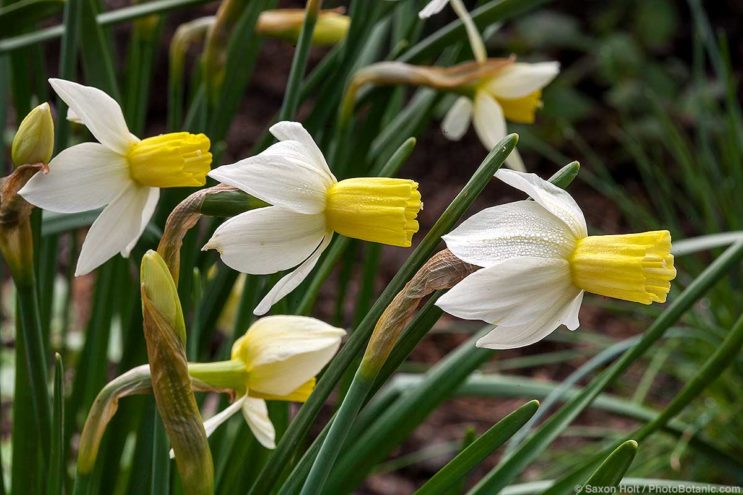
Narcissus ‘Sailboat’
Tazetta narcissus, division eight, generally have several flowering stems per bulb and 3-20 flowers per stem. This division includes some of the tallest narcissus, to two feet tall, as well as some of the smallest, from 6-8 inches tall. Most have spreading, white or yellow petals and a short, white to pale yellow or bright orange cup. Most are tender and are best grown where winters are mild.
‘Avalanche’ (8 W-Y) is a tazetta narcissus, 16-18 inches tall, with showy clusters of 10-20 small flowers with creamy white petals and a bowl-shaped, yellow cup. ‘Falconet’ (8 Y-R) is 12-14 inches tall and has 3-8 flowers per stem with overlapping, deep yellow petals and a bright orange cup with a ruffled rim. ‘Minnow’ (8 W-Y) is just 6-8 inches tall and bears miniature flowers with white petals and a pale yellow cup.
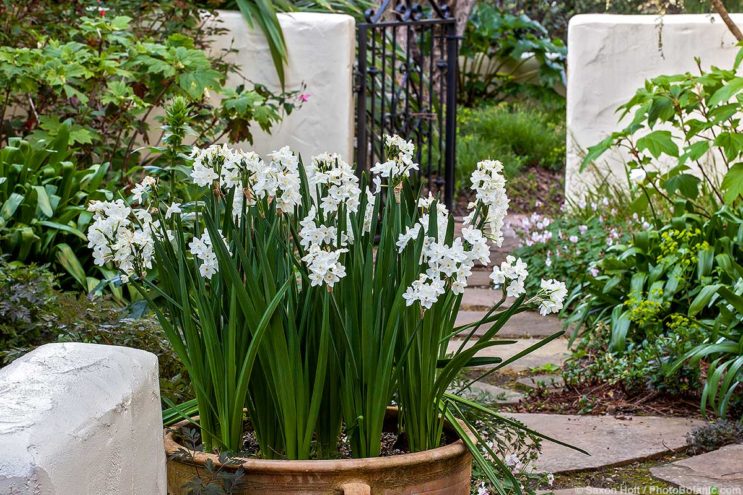
Paperwhite narcissus
Often grown as seasonal houseplants, especially in colder climates, paperwhites are tazettas too. These bear multiple small, highly fragrant flowers per stem with white or sometimes yellow petals and a white to pale yellow cup. ‘Ziva’ (8 W-W) is a popular paperwhite.
Narcissus poeticus, the narcissus of ancient times and one of the first to be brought into cultivation, is the species on which the description of the genus Narcissus is based. Classed as division nine, poeticus cultivars have highly fragrant flowers with wide, slightly reflexed, pure white petals and a short, yellow cup with a green or yellow center and a bright red rim. These are some of the latest narcissus to flower and usually bear one flower per stem. ‘Actaea’ (9 W-YYR) is one of the most commonly available poeticus cultivars. The variety recurvus has narrower, more reflexed petals.
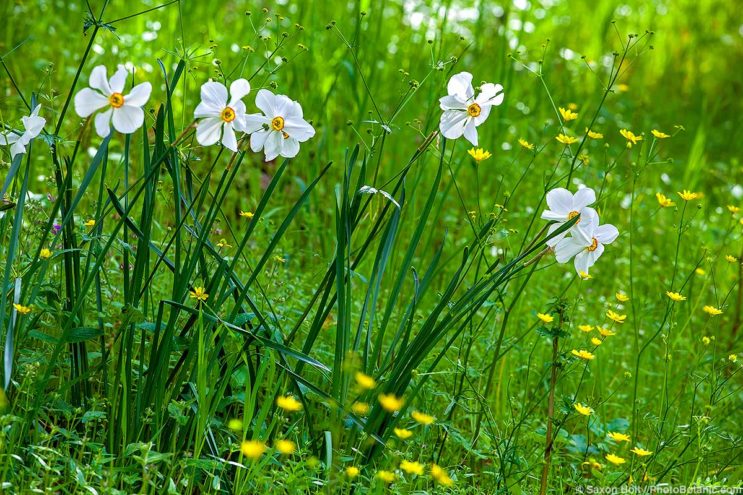
Narcissus poeticus var. recurvus
The few narcissus mentioned here barely scratch the surface of the many cultivars currently available in nurseries and online.
There are narcissus with both double petals and double cups that when packed together in a vase look a lot like peonies or little double roses. There are narcissus with small-cupped flowers, others with large cups, and a few with no cups at all.
Some narcissus have pendant flowers and others have flowers with small, barely noticeable petals and large, prominent cups. There are many miniature narcissus, and micro-minis continue to be developed. There are very early, early, mid-season, late-season, and very late-season varieties, enough to stretch out the flowering season to several months, and the range of flower colors continues to expand.
Some narcissus need winter chilling to perform well. Others are tender and do best where frosts are rare and not long lasting. Trumpets, jonquils, and tazettas are good candidates for winter-wet, summer-dry climates where winters are mild. Give them sun to light shade, good drainage, moisture during the growing season, and a mostly dry summer dormancy.
Share This!
Related Articles
By: Nora Harlow
By: Nora Harlow
By: Nora Harlow




